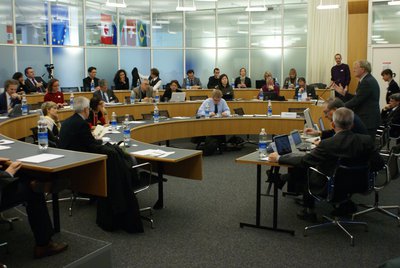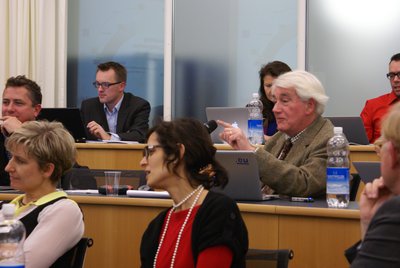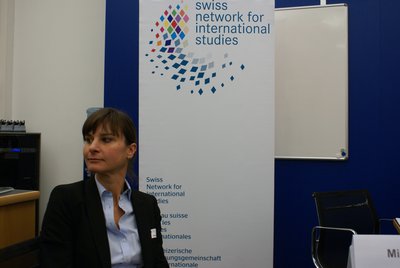10 Dec 2013
Conference Grapples with Complex Issue of Internet Governance
William Drake speaking on the opening day of the conference
The launch of the internet sparked a revolution in the way we communicate. But as it has developed, questions as to how it is governed at the global level have become more insistent.
Against this backdrop, the World Trade Institute (WTI) and Swiss Network for International Studies (SNIS) held a conference on 6-7 December to examine the institutional framework of global internet governance.
Entitled ‘The Institutionalization of Global Internet Governance: Multistakeholderism, Multilateralism and Beyond’, the biennial SNIS conference brought together scholars, representatives of international and non-governmental organisations, independent experts and stakeholders to discuss the present and the future of institutionalising internet governance, the costs and benefits and viability of different scenarios, and their implications across a range of issue areas.
Panel discussions mapped the terrain and examined different models for governance – multistakeholder, multilateral and alternative forms. The keynote address was given by Frédéric Riehl, Vice-director of the Swiss Federal Office of Communications.
“We had great discussions, both within the group of stakeholders but also with other people like practitioners and representatives of the Swiss federal administration,” commented Dr Mira Burri of the WTI, which hosted the event.
“The topic of global internet governance is now very important and it has moved away from being a technical, marginalised topic of public debate towards a key policy theme which is also of interest to broader society, especially after the Snowden [Internet surveillance] affair,” she said.
The architecture of global internet governance is highly distributed and involves multiple organisations with different areas of responsibility. For example, ICANN governs internet names and numbers, while the World Trade Organisation (WTO) sets rules applicable to global electronic commerce. Behind these are different models of governance. The WTO represents states – the multilateral model - and ICANN, a non-profit organisation, operates on a multistakeholder model in which governments, business, the technical community and civil society all participate fully.
Universal concern
“The idea behind the conference was that there’s a lot going on right now in the internet governance environment that’s very important and may be coming to a head politically. There’s the possibility of some significant changes being made in the next few years and some of these issues are very divisive at the international level,” said co-organiser William Drake of the University of Zurich.
“This is an issue of concern to anyone who uses the internet, indeed anyone living on Earth. Because the internet affects the economy, it affects society, it affects culture and it affects politics - even if you’re not a user.”
Drake said that surveillance had animated interest in governance debates. “However the reality is that the surveillance activities pursued by the US, European and other states are largely going to be untouched by anything we might do in internet governance, and internet governance frameworks are not responsible for the fact that surveillance occurs.”
Looking ahead, Drake said evolution rather than revolution was the watchword for internet governance. “It may be that there will be new mechanisms for governments to come together with other stakeholders to try to address issues that don’t currently have a home within the existing institutional architecture,” he said.
Mira Burri said the topic of the conference was one that fitted well with the interdisciplinary mandates of both SNIS and the WTI, as they seek to strengthen links between the academic community, international organisations and civil society.
“We are very fortunate to host this conference. It’s only the third SNIS conference and the second time they’ve hosted something of this magnitude outside Geneva,” she said. Conference proceedings will be published in a book and a short film will be available on both the WTI and SNIS websites in 2014.
Further info
Presentation by Mira Burri
Presentation by Bertrand de la Chapelle
Powerpoint presentation by Milton L. Mueller
Link to SNIS conference slideshow





